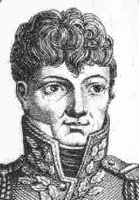General Jean Baptiste Broussier

Born: May 10, 1766
Place of Birth: Ville-sur-Saulx, Meuse, France
Died: December 13, 1814
Cause of Death: Apoplexy
Place of Death: Bar-le-Duc, France
Arc de Triomphe: BROUSSIER on the north pillar
Pronunciation:
Originally studying at the seminary of Toul, Broussier was elected capitaine of the 3rd Battalion of Volunteers of Meuse in September of 1791. He served under Beurnonville in the Army of the Center and then the Army of the Moselle, and he was wounded at the combat of Wavren near Consarbrück in December of 1792. Broussier was promoted to chef de bataillon in February of 1794 and later that year he joined the Army of the Sambre and Meuse. In 1796 he joined the 43rd of the Line and at the end of the year he was wounded by a ball to the forehead. The next year Broussier joined the Army of Italy where in March he seized Stepizza. He went on to be the first in the assault and seizure of Fort Chiusa near the Tarvis and General Bonaparte promoted him to chef de brigade for his accomplishments.
In 1798 Broussier joined the Army of Rome in the staff of Duhesme's division. That December he served at the Siege of Civita del Tronto before fighting at Pescara and winning at Fourches Caudines. In January of 1799 Broussier seized Bénévent, won again at Fourches Caudines, served in the attack of Naples, and then was promoted to général de brigade by General Championnet. With the Army renamed as the Army of Naples, Broussier continued to serve under Duhesme and in February he seized the fort of El Carmine and was ordered to guard Apulia. That March he was relieved by the Directory alongside Championnet and Duhemse for misappropriation of funds. A council of war was supposed to meet to judge him, but it never did. Instead in April Broussier was released and in November he took command of Valenciennes.
In March of 1800 Broussier was designated for the Army of the Reserve, joining Loison's division. Taking part in the campaign in Italy, he served at Fort Bard. In June Broussier ordered the blockade of Pizzighettone, served at the crossing of the Adda, won at Gera and Aspinadi, and then seized Cremona. Afterwards he was sent briefly to Amiens before returning to Italy to join Rochambeau's division. Broussier commanded the division at the crossing of the Adige on January 1st, 1801 and then he was named governor of Milan where he served for the next two years.
In 1804 Broussier returned to Paris to serve in the 1st military division and the following year he was promoted to général de division. In September of 1805 he commanded Paris and then in November he was sent to serve as chief of staff of the Army of the North. In 1806 Broussier took command of the division of reserve before being sent to Italy where he took command of the 2nd Division of II Corps.
For the campaign of 1809, Broussier remained in Italy in charge of the 2nd Division. That April he was defeated at Dignano, he commanded the left at Sacile, he covered the retreat, and then he took command of the 1st Division of the corps of the right under General Macdonald. In May Broussier served at the Piave, at Villanova, at Prewald, at the Tarvis, then he seized Laibach and took Graz. For much of June he blockaded the fort of Schlossberg before he lifted the siege and evacuated Graz. Broussier then defeated Gyulay at Callsdorf and retook Graz. After the Army of Italy reunited with Napoleon's forces in Austria, Broussier and his division played an important part in the victory at the Battle of Wagram. In the following months he was then named a Grand Officer of the Legion of Honor and a Count of the Empire.
In 1810 Broussier commanded the 2nd military division of Italy at Brescia and then in 1811 he commanded the 2nd Division. For the campaign against Russia of 1812, Broussier commanded the 14th Infantry Division as part of Prince Eugene's IV Corps in the Grande Armée. He served at Ostrowno in July, Borodino in September, Maloyaroslavetz in October, and at Krasnoé in November. After surviving the retreat, in April of 1813 Broussier was named a Commander of the Order of the Réunion. That June he took command of the 3rd Division of the Corps of Observation of Mainz. In November Broussier was named commander of Strasbourg and Kehl. After Napoleon's abdication and the Bourbon Restoration in 1814, Broussier was named commander of the department of Meuse and a Knight of Saint Louis. He died of apoplexy that December.
Bibliography
Updated August 2017
© Nathan D. Jensen